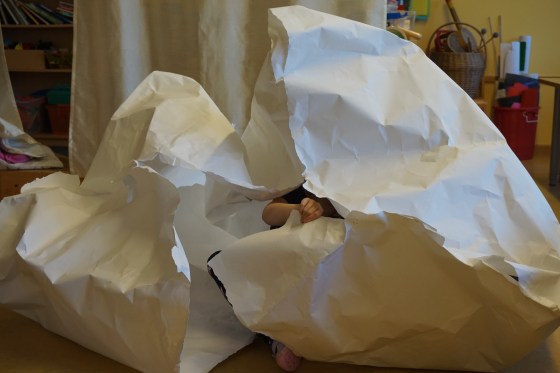
What does it mean to produce a theatre performance for children? Where do theatre and performativity begin? What is artistic research and how does it change the processes of creating a play? During the festival breakfast the team of the Schaubude production “¡ca-razy! Attempts at Chaos, Flying, and Machines,” Franziska Burnay Pereira, Alpha Angelina Kartsaki and Susann Tamoszus, gave a lecture on their research practice, presented here as a shortened transcript.
Franziska Burnay Pereira: “¡ca-razy! Attempts at Chaos, Flying and Machines” was preceded by a theatrical research project with children called TUKI ForscherTheater, a programme in the field of cultural education. The concept is to work with children on a topic of their choice and afterwards to develop a theatre play/performance for children according to their ideas. So for seven months we cooperated with the Kindergarden Pfiffikus and worked with 15 children at the age of 5 years. There were two so-called research journeys. After each journey the children presented their research results or the questions they developed in a performative setting. Now, we will share with you some insights we’ve made working with the children by presenting three of our research questions.
How can moments of transformation be captured for a performance?
Susann Tamoszus: Paper, for example, is an incredibly changeable aesthetic material from which shapes, beings and creations can be formed, destroyed and recreated. Our focus was to examine different materialities, to discover their features and to give space to the process of transformation. It was interesting to observe how the children interacted with prepared materials as well as with materials found by chance, such as fire-beetles found in the kindergarden that gave rise to an interest in insects.
During the process we took pictures, recorded statements of the children and documented their descriptions and little sketches in logbooks. Those were preceded by the observation and collection of ideas, as well as the immediate verification of the children’s assumptions. The children deformed materials, assembled one material with another, turned them into something completely new. The exhibition of body parts and other materials as hybrids ultimately led to the experimental arrangements of bodies and materials during the rehearsals for the actual performance, “¡ca-razy!.” Often “accidental findings” and “by-products” of the experiments led to the research questions for the next unit.

Can you re-invent something from broken things?
Franziska Burnay Pereira: Following that question, together with the children, we examined and looked at structures that reminded us of destruction; structures that tell of a broken condition, like broken glass, broken tiles or pictures of withered, cracked earth in the desert. Afterwards, we felt the need to break stuff ourselves, to get a close look at these chaotic patterns. In this context the children were asking if it is possible to control the moment of destruction, they wanted to examine how things break and if so, does it always break in the same way, is it possible to break something properly? One attempt to conserve those experiences we’ve made was to draw or copy broken patterns after each action. By comparing our results we discovered that the pattern of a broken glass pane or the cracks of broken porcelain, for example, resemble patterns of insect wings, thus we looked at a lot at pictures of insect wings and tried to find common features.
We produced one of these chaotic patterns by crumpling paper to study the resulting cracks. We put a glass plate over the paper and traced the cracks with a 3D pen, which led to the idea of creating (insect-)wings later on.
Further on, we explored the question of what can arise from moments of destruction; how does one create and destroy at the same time? From single parts of an old music system, which was disassembled by the children with tools like vice, saw and hammer, and the insect wings, made of filament from the 3D pen, the children assembled hybrid insect-machine-creatures. Those creatures gave the idea to the title of our performance “attempts at chaos, flies and machines.” So due to our question each child re-invented something from a broken thing.

How does destruction sound?
Alpha Angelina Kartsaki: The children destroyed a music device and two computer keyboards during our research journey. Because they were really excited that they were allowed to do something that they are not normally allowed to do, we decided to go further in the field of destruction and to also explore the sound of destroying.
So we visited noise expert Sebastian Schlemminger in his studio. The children broke porcelain plates and glasses and we recorded their sounds. Afterwards, we put these sounds in a midi keyboard and the children improvised their own compositions with their sounds of breaking.
In our performance we used these original breaking sounds produced by the children: sometimes pure and sometimes in a more elaborated composition.

Franziska Burnay Pereira: After working with the children we took one week to collect and re-arrange questions, materials and specific research moments. During rehearsals, we established an assembly table or even a mixer with lots of little notes which got re-arranged if someone felt the need to combine one sample with a different one; anyway, things we tried out were always examined in regard to the research questions we’ve worked out with the children.

Photos: Schaubude Berlin & Franziska Hauser
!CA-RAZY! ATTEMPTS AT CHAOS, FLYING, AND MACHINES (¡ver-rückt! Versuche zu Chaos, Fliegen und Maschinen) premieres on October 27, 2019 at Schaubude Berlin.
Funded by Robert Bosch Stiftung. The research phase was funded by Theaterpreis des Bundes.
Direction: Franziska Burnay Pereira
Performance, music: Alpha Angelina Kartsaki
Performance, figures: Gonzalo Barahona
Costume Design Scenography: Michaela Muchina
Dramaturgy, Scenography: Susann Tamoszus
Lighting Design: David Scholz
Direction TUKI Bühne: Renate Breitig
Documentation: Jara López Ballonga
Check out also this blog post on !ca-razy! (in German): ¡ver-rückt! – Interview mit der Audiodeskriptorin Anke Nicolai




